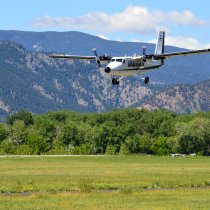Full Airborne Observation Platform Embarks on Inaugural Journey
May 2, 2012
NEON's Airborne Observation Platform (AOP) will depart on its inaugural test flights out of the Grand Junction Regional Airport starting this Sunday and continuing into next week. AOP will conduct its first test flights with a full suite of airborne remote sensing instruments aboard a Twin Otter aircraft. Twin Otter International, a Department of Energy- and NASA-approved operator, provides aerial survey, surveillance and airborne research aircraft as well as engineering and technical support to the science community (and supports science globally). Part of the instrumentation that will be used was developed in collaboration with NASA’s Jet Propulsion Laboratory. The flights will occur between May 5 through May 11, 2012. NEON, with funding from the National Science Foundation, is building a network of field sites across the U.S. utilizing cutting-edge technology that will gather and synthesize continental-scale data over 30 years on the impacts of climate change, land use change and invasive species on natural resources and biodiversity.
One of NEON’s goals is to provide detailed aerial data about regional landscapes and vegetation, which will be collected using remote sensing by the AOP. The AOP platforms will consist of remote sensing instrumentation deployed on three Twin Otter aircraft that fly scientist-defined and routine patterns over all NEON sites. The NEON instrumentation mounted in the Twin Otter planes includes an imaging spectrometer operating in the visible to shortwave infrared region of the spectrum, a waveform light detection and ranging (LiDAR) instrument, and a high-resolution digital camera. The powerful combination of biochemical and structural information provided by spectroscopy and waveform LiDAR can be used to observe and quantify pest and pathogen outbreaks, responses to disturbances like wildfire, and observe many features of land use.
The camera and LiDAR are off-the-shelf instruments but the spectrometer is a state-of-the-science instrument co-developed with NASA’s Jet Propulsion Lab and the Carnegie Institution and is itself a major scientific advance. The Grand Junction flights will be used to prepare the instrumentation and crew for official flights over NEON sites in the near future. Airborne remote sensing bridges the gap between ground-based observations and satellite-based remote sensing. The measurements provided by the AOP will allow NEON to link processes on the ground with their consequences at continental scales. An example of a continental-scale ecology issue that can be analyzed using the AOP platform is is the spread and impact of the Mountain Pine Beetle in western North America.

